Library renovation improves technology, provides more study space
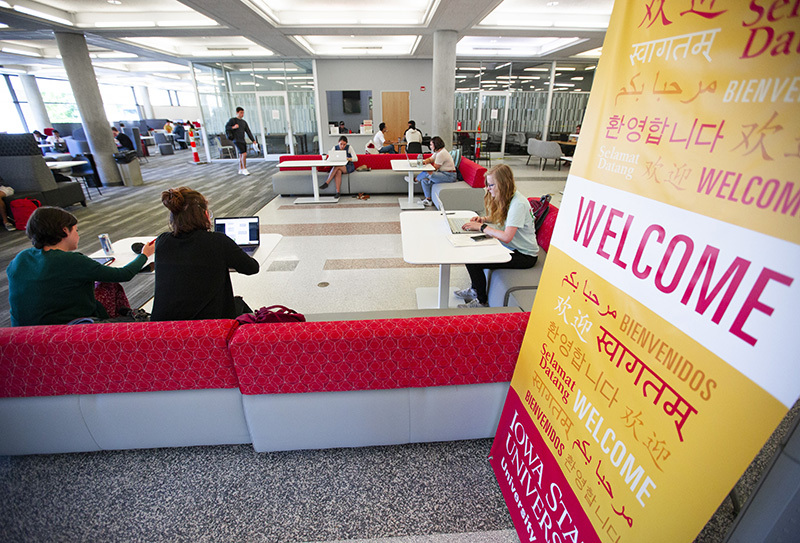
Students study at tables and benches in an open area just inside the main doors of Parks Library on Monday. Photos by Christopher Gannon.
Seven new collaborative study rooms, comfortable seating options bathed in natural light and a central location for the main desk now welcome visitors to Parks Library. But it's hard to miss what students say is the most vital addition after a summer renovation.
"Each year we conduct a student assessment survey and the need for more outlets is always one of the top requests," University Library interim dean Hilary Seo said. "Although we may never have enough, we are surely headed in the right direction."
Plenty of plug-ins for phones and computers are part of the new collaboration area on the south first floor, formerly occupied by the circulation desk and staff offices. Students' complimentary words are on a whiteboard where the library invited feedback on the changes.
The project was funded by a $200,000 donation from the Roy J. Carver Charitable Trust, $125,000 from the university maintenance and improvement committee, and private donations. Seo attributes much of the library's success to donors and their ability to help faculty and staff respond to the evolving needs of the students.
"It used to be physical books and journals that drew the students in, but now they are able to access those resources with the click of a button," Seo said. "We see an uptick in requests for additional study spaces annually, and this year we were able to make significant progress in creating a library that our students need."
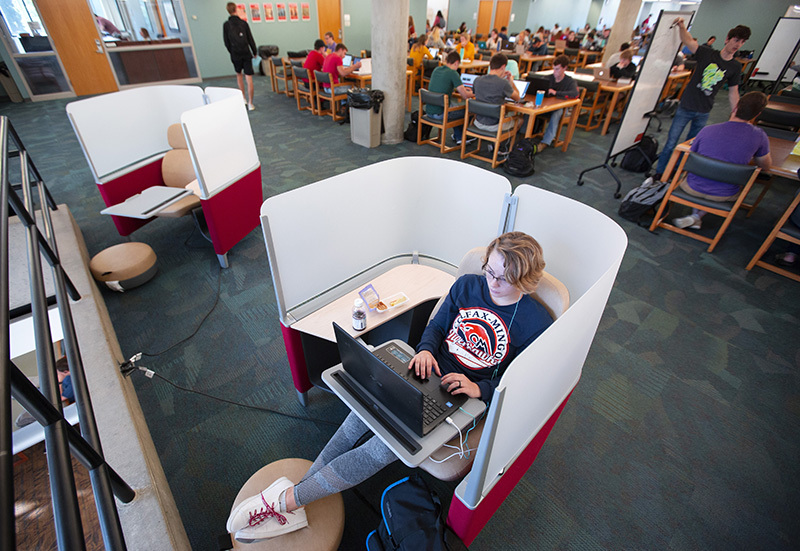
Freshman Kyla Lampman of Altoona studies in a new Brody WorkLounge on the third floor of Parks Library.
Comfort
With a variety of seating options, the renovated space accommodates more than 200 people. Everything from booths to sofas with tables seem popular, it all is being used.
Two seating options have become clear favorites. Twelve Brody WorkLounges throughout the library -- think individual mini-cubicles -- feature a reclining seat, foot stool, adjustable table to hold a laptop and small work area.
"These are the first chairs to become occupied in the morning," said library communications specialist Monica Gillen.
The "Brodys" give individuals privacy, as do high-back chairs in front of the south windows. Seo isn't sure if it is the ability to look out the window or the comfort of the chairs that draw students, but she knows she likes the change.
"Previously, the blinds were always closed, but now all the window treatments are gone," she said. "When I walk up, I can see all the way through."
There are numerous general-use Apple and personal computers throughout the new space, in addition to a large monitor mounted on a wall students use for group work, flipping from one computer to another. Tech lending, the laptop and equipment checkout service, has returned to its permanent location in the lobby.
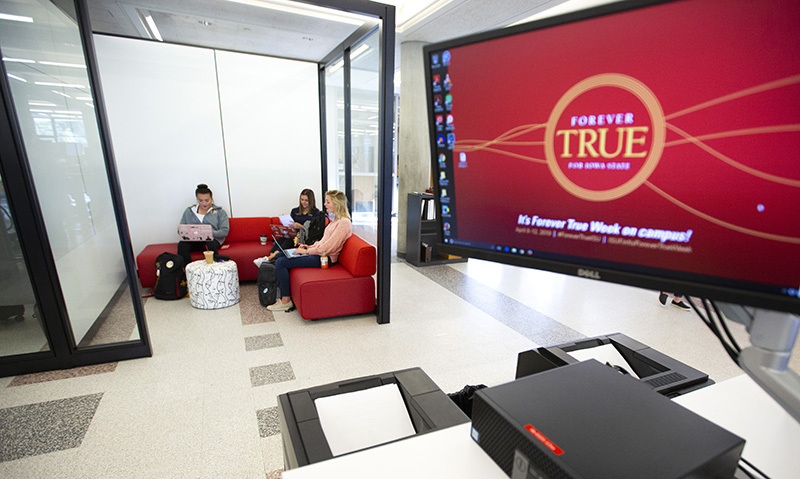
From left, students Gabriella Aguire, Hannah Morrow and Claire Greiner study together in a new study room on the first floor of Parks Library.
Technology demand
Each collaborative room has a presentation monitor, whiteboard and audio/video conference capabilities. Three are named after donors to the project: Linda Shallcross Soukup, Richard Soukup and Lois and John Mather.
"What our faculty are asking our students to do is not the same as years ago," Seo said. "There used to be a lot of papers and individual work, but now they are being asked to do group projects, group presentations and technology-assisted presentations."
The rooms provide a space where presentations can be practiced, recorded and tweaked. Students can sharpen their interview skills before conducting one via video conferencing.
More than comfy chairs
Although much of the renovation focused on student comfort and modern learning tools, there were other objectives. The updates have had impacts, big and small, on other parts of Parks Library.
The third floor has become a collaborative space where tutors work with groups and whiteboards are as good as gold. There are tables and chairs that accommodate individuals and groups and 10 height-adjustable tables thanks to a University Library and Student Government collaboration.
The area can be more boisterous, but library leaders are fine with that.
"Students really do self-govern and take over the space how they see fit," University Library business services director Brent Swanson said.
What may not be quite as obvious at first glance is the art on the walls.
"Students tell us they want to connect and see themselves in this space, and all the artwork in Parks Library was originally done by white men," Seo said. "The art we have brought in recently includes female artists and artists of color, and the content of the art is different."
Seo hopes the art will spark something in students and put them on a new path of innovation.
Time to change
During the past 12 years, Parks Library has seen its fair share of change, especially with the addition of Bookends Cafe. Having food and drink inside the library -- previously unthinkable -- has become commonplace.
Seo said when Iowa State began to experience its record enrollment growth eight years ago, it became clear updates were needed.
"We started thinking, 'What are great spaces we can use for our students and how can we use them in different ways?'" she said.
That is why the circulation desk moved and now occupies a significantly smaller footprint as the main desk. With the growth of online resources, the need to process books and journals has declined. Even the number of bookshelves shrunk, opening up space in a time when it is at a premium across campus.
"We are reducing the footprint of things that students don't immediately need," Seo said. "This doesn't mean we are taking away books or not supporting faculty and students' needs for collections and resources. We are putting more of them off-site, arranging them in ways that are more intuitive."
There is an emphasis on customer service and a concept staff at the library work with every day.
"We have heard the phrase 'you can't be all things to all people,' but we certainly try," Gillen said.
As workflow stabilizes, ISD's second phase turns to outreach and improvement
In the three months since Workday and improved service delivery (ISD) launched July 1, human resources and finance ISD teams have been hard at work processing transactions in Workday and handling employee issues and requests through ServiceNow. An initial spike in transactions after go-live and another starting Aug. 19 when faculty and students returned kept both teams focused on a high volume of requests.
Now that the workflow is beginning to stabilize, phase II of ISD has begun. That includes additional training, team members continuing to develop relationships with units and departments, and leadership teams responding to campus feedback on Workday, ServiceNow and ISD team performance.
While implementation has been an overall success, there have been bumps along the way -- some expected and some unexpected. As project leaders said in the lead-up to go-live, full stabilization will take months.
Questions or comments?
Direct service requests or questions to HR_delivery@iastate.edu or finance_delivery@iastate.edu.
Submit general feedback at WorkCyte_feedback@iastate.edu.
"With the significant amount of change that has occurred through the implementation of Workday, ISD leaders have heard feedback from some of you that things are not working in a way that is helpful yet. We take this feedback very seriously and are working diligently to deliver the improvements that Workday and ISD will bring," said Dwaine Heppler, associate vice president for human resources services and strategy.
ISD advisory committee
The ISD advisory committee has met four times since July 10. Charged with providing ongoing feedback and guidance on the ISD model, the 15-member committee represents a diverse group of stakeholders, establishes accountability and serves as a link for campus engagement. Since go-live, the committee had learned:
- Finance and HR service delivery teams continue to work through what business process information both teams should be able to see, creating the perception that finance and HR service delivery teams are not working well together.
- Handoffs between finance and HR service delivery teams are not smooth, and there are too many of them.
- Information is not visible in Workday, or instructions on how to access the information in Workday are not clear.
- Faculty, staff and managers are processing too many Workday transactions.
- Hiring faculty and staff requires more steps, and ensuring funding is available and securing needed approvals has been significantly impacted by new people in roles, people in different roles and lack of clarity about Workday. Job management (JM) support, graduate assistant (GA) support and timekeepers don't know how to process Workday transactions or are pushing initiation of those transactions to faculty and staff.
- Issues or requests submitted through Finance_Delivery@iastate.edu or HR_Delivery@iastate.edu are not addressed quickly or are passed around. In some cases, individuals are notified an incident is resolved though they don’t feel the root cause of the issue was addressed.
Action steps
Actions that have been taken or are planned as part of phase II include:
-
Finance and HR ISD teams are contacting and meeting the departments and units they serve. Contact your local ISD team for its outreach schedule or to request a session with them. Benefits of connecting with your ISD team include:
- Deepening relationships to enable direct contact and issue resolution
- Reviewing business processes and learning Workday tips
- Ensuring appropriate delegations are set so faculty and managers can focus on their work and not Workday approvals
- Helping local staff in Workday support positions (JM support, GA support, timekeepers, cost center managers, business unit managers) better understand their roles
- Finance and HR teams are holding working sessions and trainings to understand their respective business processes and how to collectively ensure that transactions flow smoothly.
- ISD staff are receiving advanced training on ServiceNow to enable better customer service.
- HR coordinators emailed all employees over the past week to introduce the HR teams, including the HR partner, staff recruiting specialist, senior HR partner and the coordinator's backup. The memo also encouraged recipients to escalate service issues within the organization with specific information so items of concern can be addressed quickly with specific solutions.
- Starting Oct. 1, finance and HR delivery teams will solicit feedback via a customer satisfaction survey in ServiceNow automatically sent to each employee after an incident is resolved. The four-question survey also will allow open comments.
Going forward
Heppler said ISD leaders will continue to listen to feedback and address issues as they become known. They ask campus users to:
- Please be patient. Service team members are still learning Workday and ServiceNow as well as their roles, customer bases and how local processes have been affected by Workday.
- Contact your local HR coordinators or finance specialists for help. They can help set up Workday to ensure you receive the right information and approvals, or connect you with the appropriate local Workday support staff.
- Continue to provide constructive feedback. Service delivery and Workday can improve only with timely and specific feedback.
- If you are not satisfied with the level of support provided by your service delivery team -- or finance or university human resources overall -- please forward your concerns up the service organization's management chain.
Related story
- Leaders present improvement plans for Workday, service teams, Sept. 12, 2019
Employee flu shot clinic is set for Oct. 7-18
ISU WellBeing, with assistance from occupational medicine, will sponsor a flu shot clinic for university employees next month. The clinic will be open Monday through Friday for two weeks (Oct. 7-18, 9 a.m.-4 p.m., 205 Technical and Administrative Services Facility).
No appointment is needed, and registration is paperless. Individuals will check in on a smart tablet with the nurse who administers the vaccine. Employees need their nine-digit university ID number to check in. The vaccine is provided at no cost for these employee groups:
- Faculty, professional and scientific, and merit
- Postdocs
- ISU Foundation
- Iowa State Daily benefits-eligible staff
- Retirees on the ISU health plan who are not yet 65 years old
Only ISU employees are eligible to receive a flu shot, their spouses and children are not. ISU students and visiting scholars should contact the Thielen Student Health Center for vaccination information.
If possible, employees are asked to wear a short-sleeve or loose-fitting shirt to give the nurse easier access to an upper arm. Visitor parking is limited at TASF, so walking or biking is recommended.
Members of ISU WellBeing's Adventure2 will receive points for getting a flu shot.
The vaccine
Employees who participate in the flu shot clinic will receive a four-component vaccine that protects against A and B flu virus strains. The four viruses it contains are:
- A/Brisbane/02/2018 (H1N1) pdm09-like virus
- A/Kansas/14/2017 (H3N2)-like virus
- B/Colorado/06/2017-like virus
- B/Phuket/3073/2013-like (Yamagata lineage) virus
Alternative forms of the vaccine prepared for the 2019-20 flu season will not be available at this clinic. These include a spray/mist vaccine administered through the nose and a high-dose vaccine intended for individuals 65 years and older who are at greater risk of severe illness from influenza. Employees or retirees who prefer one of these should contact their primary care physician.
Regardless of the vaccination received, it takes about two weeks for antibodies that protect against the flu to develop.
More information about the 2019-20 flu season is online, including a Q&A on the ISU WellBeing website and a Q&A on the federal Centers for Disease Control and Prevention website. Questions may be directed to the university human resources service center, 294-4800.
Job alerts now available in Workday
Employees can now receive notifications when campus positions they may be interested in are posted online. A Workday system upgrade added the internal job alert feature earlier this month, a capability available only to external job candidates until now.
Iowa State transitioned its hiring system from PeopleAdmin to Workday this summer. Brooke Dykstra, a talent acquisition consultant in university human resources, said the system's new feature allows employees to create job alerts and receive notifications when positions that match are posted.
"This is a convenient, time-saving feature for ISU employees looking for either new positions or promotional opportunities," Dykstra said. "They no longer need to look at the careers site on a daily basis. Instead, positions that match their interests can be emailed to them directly when they are posted."
Find your fit
Job alerts can be set up and saved using the search mechanism on Workday's "Find Jobs" site, which is available through the "Career" icon on employee Workday homepages. From there, faculty and staff can enter keywords in the search field and narrow the field with specifics such as job category, full/part-time appointments and hiring unit. Users can edit and delete job alerts and set up preferences for daily or weekly email notifications.
A WorkCyte job aid is available to walk users through the process of setting up a job alert. There is no limit to the number of alerts employees may create.
Related story
- Internal job applications will be easier with Workday, June 7, 2019
More hammock poles offer tree relief
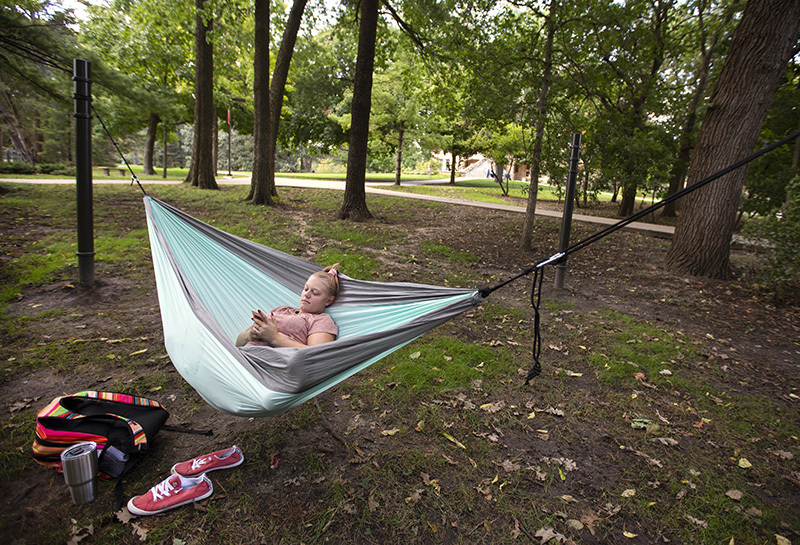
Autumn Gannon, a freshman in early childhood education from Grand Junction, uses the new hammock posts installed between Catt and Curtiss halls. Photo by Christopher Gannon.
When the sun comes out on campus, so do the hammocks. To help save trees from damage, facilities planning and management (FPM) added 12 hammock poles this summer to popular hangout spots.
"We added poles to places where there was a need, but not close to anything that is vulnerable to high-volume use," said Rhonda Martin, FPM landscape architect.
Six hammock poles were installed last year as part of a pilot project to preserve trees from hammocking wear and tear. Sites for the dozen poles added this year include west of the Jischke Honors Building (four), south of LeBaron Hall (three) and east of Pearson Hall (five). Locations were selected with input from FPM's campus tree advisory committee, Student Government and the Green Umbrella student group.
Multiple hammocks can be hung on the metal poles. Rather than using hooks, the poles have bands that prevent hammock straps from slipping. Each pole has three bands toward the top and a fourth band closer to the bottom for slacklines -- a modern, more elastic take on tightrope walking.
Martin said the residence department is considering the installation of some hammock poles. FPM, which funded the existing poles, doesn't have immediate plans for more. But, Martin said, it's always an option.
"We're trying to be responsive to the students while being respectful to what can harm the trees," Martin said.
Support extended to staff who assist with student worker HR
Administrative staff who support supervisors who hire and manage student employees received some extra assistance this month in navigating their new role.
In the transition to improved service delivery (ISD), which created service teams to process the bulk of human resources and finance transactions, about 220 Iowa State staff in local departments and units were identified to fill a job management (JM) support role. Most HR activities for student workers, by far the university's largest group of employees, are handled by department and unit staff.
That's where JM support staff come in. They can process whatever routine student-employee human capital management transactions a supervisor would like them to take on.
"We wanted to have somebody local to help support the student employees and the managers of those student employees in the departments," said Mindi Balmer, information management director in university human resources (UHR).
JM support staff can see much of the same information and perform most of the same actions as a student employee's manager. That allows them to help with onboarding and offboarding, job changes, time sheet approval and adjustment, and compensation changes.
"We gave the JM support role similar access that a manager has for a student employee," Balmer said.
To enhance the proficiency of JM support staff in Workday -- which digitized what had often been a paper-based student hiring process and will provide richer data on student employees -- UHR held an information session in Howe Hall last week. A crowd of about 100 attended, giving them a chance to ask questions and get detailed tips from Balmer and other experts. Two user labs for JM support staff also were held earlier this month.
"JM support staff play a vital role in ensuring our student workers are taken care of," said interim vice president of university human resources Kristi Darr. "UHR and the Workday team are committed to staying connected with this group and other HR support roles to make sure they have the knowledge and resources needed to be able to do this work effectively and efficiently. We truly appreciate their efforts."
A video recording of the Sept. 18 information session is posted to Learn@ISU (search for the session titled "Job Management Information Session Recording"). Check out these job aids for step-by-step instructions on performing HR tasks related to student employment:
Funding request to replace LeBaron Hall heads to the state
The state Board of Regents will send a three-year (fiscal years 2021-23), $30 million building request to the state by the end of the month on behalf of Iowa State. If approved next spring by the Legislature, the funds would support a College of Human Sciences plan to replace the 60-year-old LeBaron Hall and renovate a small piece of the adjoining MacKay Hall. The intent is to create modern classroom, lab, research and presentation spaces for three departments with nationally recognized programs: apparel, events and hospitality management; human development and family studies; and food science and human nutrition.
The new building would be an estimated 70% larger than LeBaron on the same footprint. In addition to the state support, the proposed $55 million project includes $15 million in private gifts and $10 million in university funds. Associate vice president for facilities planning and management Paul Fuligni said Iowa State will seek board permission yet this fall to begin planning the facility, with a goal of holding classes in it in fall 2024.
The board's FY21 facilities funding request to the state also includes $1.2 million to replace aging transmission equipment at Iowa Public Radio (IPR). Most of that request, $875,000, would replace the antenna and transmission system for WOI-FM on campus. WOI-FM is the main signal for IPR in the Ames-Des Moines area, and serves 60,000 listeners in 15 counties.
Operations support
At its Sept. 19 meeting, the board also approved and will send to the state Iowa State's request for $7 million in additional operating support in the fiscal year that begins July 1, 2020, the same increase it sought a year ago. State law sets an Oct. 1 deadline for appropriations requests for the upcoming fiscal year. No incremental increases will be requested for the university's direct appropriations for programs and units.
President Wendy Wintersteen told board members the request, if funded, would support student success, which begins with innovative faculty and staff. She pledged Iowa State support for the board's five-year tuition plan and a holistic look at all fund sources: tuition, state support, reallocations and savings, and new revenue streams.
Wintersteen noted Iowa State's rock-bottom tuition rates among its peer universities, combined with lower enrollments, is reducing overall income.
"Like all Iowa businesses, Iowa State is experiencing increased costs for employee salaries, infrastructure, technology and services. As a result of increasing costs and lower tuition revenue, Iowa State made some extremely difficult decisions to reallocate $23 million in the current year's budget -- or 3.1% of the general university budget," she said.
Iowa State and the University of Iowa will seek an additional $2.9 million in FY21 for the four platforms in its joint biosciences innovation effort, currently supported by $1.1 million in state funds. Iowa State is taking the lead on three of the four platforms (biobased chemicals, precision and digital agriculture, vaccines and immunotherapies) identified in a 2017 TEConomy report released by Gov. Kim Reynolds. Iowa is overseeing the fourth, medical devices. A year ago, the two universities sought $4 million ($1 million per platform), so this request is for the unfunded portion of last year's request.
Wintersteen also pointed out Iowa State's value to the state. That includes accessible education to Iowans of all backgrounds (with an average 4.4 years to graduate), faculty research that responds to challenges and benefits the state's communities, a research park that serves as an "engine of economic growth and opportunity for the entire state," and innovative, research-based extension programming in all 99 counties.
Other ISU items
In other business, the board gave permission to:
- Phase out the Iowa Public Universities Application Portal, launched in July 2015, due to low use. Less than 1% of undergraduate applications at any of the three regent universities come through the portal. University of Northern Iowa provost Jim Wohlpart told board members that because of the Regents Admissions Index (which is "unique in the nation" and lets applicants self-compute acceptance to a specific university), students "don't need to hedge their bets; they only need to apply to the school they want to attend." He said 90% of resident applications are to a single regent university. Wohlpart also said the National Common Application, which all three regent universities began using since 2015, allows students to apply to many more colleges and universities, public and private.
- Demolish the Insectary building on Pammel Drive. Tenants moved into either the Advanced Teaching and Research Building or Science Hall II last year, and the building is vacant. University funds will cover the estimated $600,000 demolition cost, and the site will become green space.
- Add a bachelor of science in business analytics degree program in the Ivy College of Business, beginning in January 2020.
- Add a master of athletic training degree program in the College of Human Sciences, beginning in May 2020.
- Accept a 7-acre, five-building gift from the Committee for Agriculture Development, a nonprofit corporation affiliated with the College of Agriculture and Life Sciences. The property is on State Avenue, adjacent to the Curtiss Farm, and will be managed with the Curtiss Farm.
- Begin planning to replace the slate roof on all sections of Friley residence hall with asphalt shingles. The project also will repair or replace top-floor dormers and gutters, as needed. An estimated cost of $5.6 million to $6 million would be covered by dormitory system improvement funds.
- Sell "as is" (due to a discrepancy about its size) up to 10.6 acres of woodland on Stagecoach Road in east Ames to an adjoining property owner for $166,500, the highest of two bids received. The land was a 1954 gift to the university and previously used for forestry department teaching and research (1954-66) and leased to the city (1966-2016).
Brunnier chandeliers match Scheman era
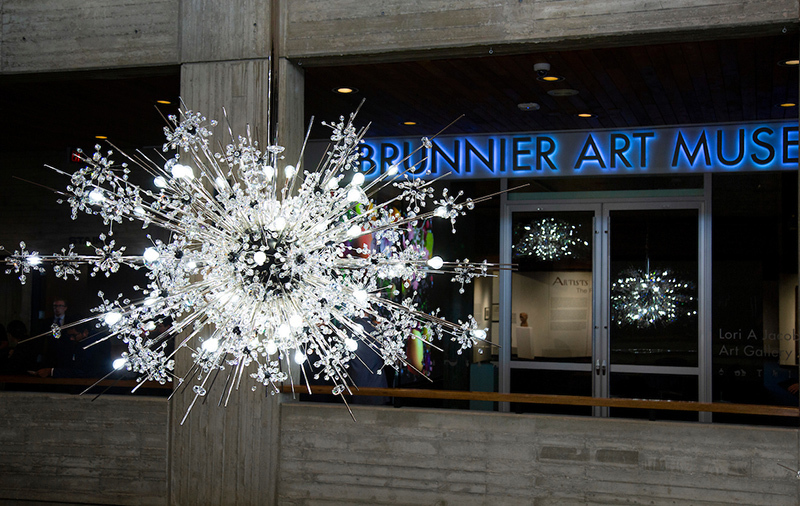
The Met chandeliers hang in the second-floor atrium of the Scheman Building, just outside the Brunnier Art Museum. Photos by Christopher Gannon.
Much of the aesthetic attention at the newly renovated Brunnier Art Museum in the Scheman Building has focused on its floor-to-ceiling glass curtain wall opening to the second floor foyer. But there's also some eye-catching glass just outside that wall. As part of the yearlong renovation of its home base, university museums commissioned and purchased three chandeliers from the Vienna, Austria-based Lobmeyr Werkstatten glass company. The trio is made of aluminum, brass, steel and nearly a thousand Swarovski pearls and crystals.
Open = on
The Lobmeyr chandeliers will be lit when the Brunnier Art Museum is open: weekdays 10 a.m.-4 p.m., weekends 1-4 p.m.
Part of the company's "Met Chandelier" line, the design was introduced to the public in 1966 when 32 chandeliers -- 11 in the lobby and 21 in the auditorium -- were installed in the new Metropolitan Opera House at Lincoln Center in New York City. The chandeliers were a gift to the United States from Austria in gratitude for the European Recovery Program (Marshall Plan) after World War II.
The celestial-themed chandeliers at the Met were designed by Hans Harald Rath (1904-68), a descendant of the Lobmeyr family who owned the company at that time. Mid-century modern in style, university museums selected them to complement the 1970s Brutalist architecture of the Iowa State Center buildings.
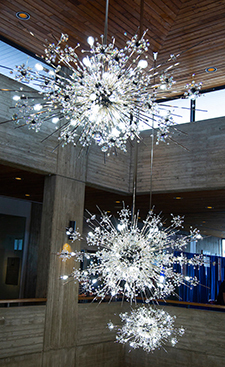
"The Met Chandeliers are the first Lobmeyr chandeliers at a university and were planned to accentuate the existing architecture of the space," said Lynette Pohlman, director and chief curator for university museums. "Our newest public art brings glamour and illumination to the Iowa State Center, home to the visual and performing arts on campus."
The chandeliers are the public art project for the Brunnier renovation and become part of the permanent Art on Campus collection. The purchase was funded by university museums' new Joyce Tomlinson Brewer Fund for Art Acquisitions, established with an estate gift from Brewer, a 1953 alumna who earned a bachelor's degree in applied art.
A list of fundraiser events for United Way
As a campus community, Iowa State has a goal of raising $410,500 in cash and pledges by Dec. 1 for the United Way of Story County. Associate provost for faculty Dawn Bratsch-Prince is the chair of the campus campaign, with vice president for extension and outreach John Lawrence serving as chair for leadership gifts. They're assisted by employee volunteers across the university.
One way units can hit their mark is through fundraising initiatives opened to the wider campus community. Below is a list Inside staff have compiled of events open to all. Send us your United Way fundraising event and we'll add it to the list.
Online auctions
- Student Affairs division online auction, closes at noon Friday, Sept. 27
- College of Human Sciences online auction, Sept. 27-Oct. 4 (noon)
- College of Agriculture and Life Sciences online auction, Oct. 7 (8 a.m.)-Oct. 10 (4 p.m.)
- College of Liberal Arts and Sciences online auction, Oct. 7-11
- University Library online auction, planned for October (TBA, contact Susan Jasper or Jeff Kushkowski to donate an item)
Other events
- ISU Extension and Outreach annual United Way picnic, Friday, Oct. 4 (11:30 a.m.-1:30 p.m., Extension 4-H Building patio), includes a $5 walking taco lunch, silent auction and games with prizes
- Ames Laboratory Hot Wheels car race and bake sale, Oct. 9 (1-2 p.m., 301 Spedding), cars can be purchased at the event
